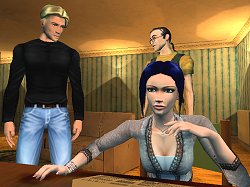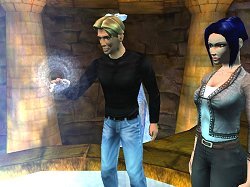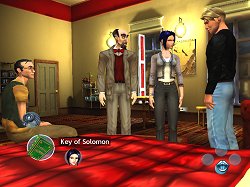|
Broken Sword: The Sleeping Dragon
 The first two Broken Sword games, The Shadow of the Templars (aka Circle of Blood) and The Smoking Mirror are fondly remembered, perhaps even revered in the case of the first, by many adventure game players. What made them so entertaining and enjoyable can be easily gleaned from the earlier reviews, and they still stand up well today.
It's a pedigree to be proud of, and one possibly a little difficult to live up to. The Sleeping Dragon succeeds triumphantly in many respects but the jury may still be out on the interface and the puzzle selection. The first two Broken Sword games, The Shadow of the Templars (aka Circle of Blood) and The Smoking Mirror are fondly remembered, perhaps even revered in the case of the first, by many adventure game players. What made them so entertaining and enjoyable can be easily gleaned from the earlier reviews, and they still stand up well today.
It's a pedigree to be proud of, and one possibly a little difficult to live up to. The Sleeping Dragon succeeds triumphantly in many respects but the jury may still be out on the interface and the puzzle selection.
Six years have passed since their last meeting. George is a patent attorney, based in Idaho but currently on a trip to the Congo to meet with an inventor and sort out the patents on his new energy machine. Nico is still waiting for her big journalistic breakthrough in Paris and is on her way to interview a computer wiz who wants to tell her about the end of the world. Both arrive just prior to a murder. And their adventures begin.
You get to play both George and Nico, separately at times and together at others. Their stories converge and are ultimately shared. They need to co-operate to complete parts of the game and move forward.
The Sleeping Dragon is completely keyboard controlled, and utilises an icon system to undertake most actions and tasks. Move George or Nico around with the arrow keys (or whatever keys you decide) and if something is of interest they will look at it and it will sparkle. Various icons may then appear at the bottom right of the screen, depending upon what action is available, for example talk, use, look, pick-up, climb or perhaps jump. Choose the action you want, and the character will attempt to carry it out.
Similarly, press the space bar and the inventory will appear. Scroll through the items and again use icons to choose your actions.
There is no need to worry about keyboard agility with the jumping and climbing, as you don't do the leaping yourself. Choosing the icon is enough if a leap or climb is possible.
You do have to run away a few times though, and for that you do need some keyboard agility to steer George or Nico. You will also need to creep past some gun-toting guards more than once, timing and the dark shadows being your best allies. George and Nico can die, but if they do, the game will return you to just before the fatal move.
Like its predecessors, the game is animated, only this time it's in 3D. The animation is of the highest quality, and sounds and lighting are superbly used. There are numerous cutscenes interspersed amongst the exploration and puzzle solving. It's not a hard game, and is fairly linear, but some puzzles may hold you up. Many are of the find and use the right item variety, although there is the sneaking referred to and some box pushing and stacking puzzles.
 I loved this game. Or should I more accurately say, I loved the experience that is this game.
I like animated films as well as rollicking adventure stories, and this was both. The extensive use of cutscenes, the exceptional 3D animation and the fine musical score gave The Sleeping Dragon a very movie like feel, and the plot could have been Indiana Jones at his finest. It bounces around the world, which of course needs saving. Diabolical ancient forces are being unleashed, aided and abetted by henchfolk both evil and beautiful.
Driven by its story, its characters and its design, it is not a game to sit and ponder over with a pad and pencil, but rather something to be sucked into for the 15 to 20 hours it will take to complete.
The two central characters shine. George and Nico have lost none of their charm in their 6-year break. Their banter remains both witty and ascerbic, a credit to the writing team. George is also voiced by the same actor as in the first two games, ensuring a comfortable familiarity if you have met him before.
The supporting cast is good too, generally well voiced and with personas of their own. There are some nice digs at some cultural stereotypes (offer an Aussie male a free beer or the opportunity to save the world and what do you think he would choose), and some of the best conversations occur with or between the extras. Keep an ear out for the two guards discussing Petra's interrogation habits, and the toilet attendant's observations of the male gender should not be missed.
You don't need to have played the first two games (or either of them) but you will appreciate some of the situations more, as well as experience a depth of characterisation if you have. There are also some nice in-game references to earlier events, some obvious and some far less so, as well as returning characters. Unlike some games, this really is a sequel, but it stands up well all by itself.
In the driver's seat I loved this game. Or should I more accurately say, I loved the experience that is this game.
I like animated films as well as rollicking adventure stories, and this was both. The extensive use of cutscenes, the exceptional 3D animation and the fine musical score gave The Sleeping Dragon a very movie like feel, and the plot could have been Indiana Jones at his finest. It bounces around the world, which of course needs saving. Diabolical ancient forces are being unleashed, aided and abetted by henchfolk both evil and beautiful.
Driven by its story, its characters and its design, it is not a game to sit and ponder over with a pad and pencil, but rather something to be sucked into for the 15 to 20 hours it will take to complete.
The two central characters shine. George and Nico have lost none of their charm in their 6-year break. Their banter remains both witty and ascerbic, a credit to the writing team. George is also voiced by the same actor as in the first two games, ensuring a comfortable familiarity if you have met him before.
The supporting cast is good too, generally well voiced and with personas of their own. There are some nice digs at some cultural stereotypes (offer an Aussie male a free beer or the opportunity to save the world and what do you think he would choose), and some of the best conversations occur with or between the extras. Keep an ear out for the two guards discussing Petra's interrogation habits, and the toilet attendant's observations of the male gender should not be missed.
You don't need to have played the first two games (or either of them) but you will appreciate some of the situations more, as well as experience a depth of characterisation if you have. There are also some nice in-game references to earlier events, some obvious and some far less so, as well as returning characters. Unlike some games, this really is a sequel, but it stands up well all by itself.
In the driver's seat
The navigation system took me a little while to become comfortable with, but then it was reasonably plain sailing. It does require two or three fingers at times, and I confess I did crash George and Nico into more than one wall, usually when the camera orientation changed. Up would become down and ... bang! It was nuisance value most of the time, except in the running away parts. Crashing then can be fatal. I swore at it occasionally but generally felt navigation was ok.
I was impressed, though, by the icon system, particularly for jumping and climbing. Another excellent aspect is your participation in some of the cut scenes. Certain actions are required at the right time for the scene to end well. It made watching an interactive event.
Some may say it is too linear, and it certainly isn't as open as some games. But linear is a tricky concept. Every game I have played requires you to achieve certain things before continuing, and some things only become accessible after doing others, so in that respect every game is linear. The Sleeping Dragon is generally one task at a time, but I never felt constrained or suffocatingly confined. Too much good stuff was going on, which in the end is the key.
The good stuff though did not include the box pushing. There are way too many "move the crates" puzzles. The creeping may also get you down after being shot for the umpteenth time. I am definitely slightly more bald than I was when I finally crossed the sewer temple and found out what came next (I won't spoil it).
Also, whenever George and Nico are together, you only ever play George, Nico following obediently along behind. It would have been better to have mixed that up a bit. And whilst the camera angles are generally trouble free and quite fluid, they can occasionally make knowing where to creep next a bit more difficult, so some control over them would have been handy.
However for me the downsides are overwhelmed by the many positives of The Sleeping Dragon.
 I wanted to love this game but some of the potentially frustrating aspects mentioned by Steve above conspired to stop me. So instead of a loving relationship I had a love/hate relationship.
I wholeheartedly agree with many of Steve's observations. The 3D graphics are some of the best I've seen. The cut scenes are brilliant, sweeping you along with the story. The musical score is excellent; it soars at times and is dramatic when required. It was good to be reunited with George and Nico. I breathed a sigh of relief when I heard Rolf Saxon's George speak, and when I saw that Revolution hadn't tampered too much with the George we all know and love. (The early beefcake, muscleman concept drawings sent a shiver down my spine and it's clear that Revolution listened to the fans on this).
As with the first two games the dialogue is all subtitled and repartee between the main characters is cleverly written and thoroughly amusing. I was happy to see George once again reunited with his lucky lump of coal even if I didn't get the chance to throw it away. For these reasons and more I had times of tremendous fun with this game.
"Whatever happens, mouse, I love you" I wanted to love this game but some of the potentially frustrating aspects mentioned by Steve above conspired to stop me. So instead of a loving relationship I had a love/hate relationship.
I wholeheartedly agree with many of Steve's observations. The 3D graphics are some of the best I've seen. The cut scenes are brilliant, sweeping you along with the story. The musical score is excellent; it soars at times and is dramatic when required. It was good to be reunited with George and Nico. I breathed a sigh of relief when I heard Rolf Saxon's George speak, and when I saw that Revolution hadn't tampered too much with the George we all know and love. (The early beefcake, muscleman concept drawings sent a shiver down my spine and it's clear that Revolution listened to the fans on this).
As with the first two games the dialogue is all subtitled and repartee between the main characters is cleverly written and thoroughly amusing. I was happy to see George once again reunited with his lucky lump of coal even if I didn't get the chance to throw it away. For these reasons and more I had times of tremendous fun with this game.
"Whatever happens, mouse, I love you"
Where I didn't have fun was with the keyboard manipulation. And this is not a knee-jerk aversion to keyboard controlled games though they are not my favourite. I thought the keyboard was easier to use in Largo Winch, for example.
In Broken Sword 3, even when I wasn't panicking in the quick reflex action sequences but just looking around, I often had trouble getting George or Nico to go where I wanted them to. In quiet relaxed exploration this was only mildly annoying but during the "press-the-key-now" split second decision making whilst running from certain death action sequences, I very nearly threw the keyboard through the monitor. I found the navigation at these times to be unwieldy, I either ran into walls or the changing camera angle meant that I ran towards danger, not from it. Sure you get to try again (and I had lots of practice) but I find the repetition of action sequences to be tedious in the extreme. I know what I have to do but lack the dexterity to do it, so I am rewarded (penalised) by being made to repeat it over and over. This is not fun, guys!
Petra-fied
I understand that there is a place for dramatic tension but there has to be an alternative to repeated death experiences, which are inevitable sometimes at the end of a cut scene. Not only that but I couldn't relax and watch some of the entertaining cut scenes because I had to glance from keyboard to the on screen action map to watch for the icon to alert me that I now had one millisecond to press another key or fail again and start over. I don't want to dwell on this point (in fact I'd prefer to forget it) but I would have preferred a pause (a very pregnant one) before heading down the road to oblivion.
Another frustrating aspect of this game is that you can't skip any of the dialogue if you've heard it before. I pressed all the usual keys (and more) but I could find nothing that worked (perhaps I should have clicked the mouse button J ).
Moving on to the puzzles, I thought there was too much emphasis on climbing, jumping, sneaking and simply pushing boxes or blocks around in what must surely be the most expensive version of Sokoban ever produced. (Don't worry it's a lot easier than Sokoban). The first couple of times were novel and entertaining and the character animation of George doing all this was amazing and life-like. But the novelty soon wears off. That aside there are many enjoyable inventory-based puzzles, never too difficult so you do move through much of this game at an appropriately fast pace. The co-operation puzzles requiring both George and Nico were well done too though there were some missed opportunities for Nico to take the initiative. When Nico knew what to do and George didn't she could have done the deed.
Despite the bumps and jolts I still had a lot of fun with Broken Sword 3 and this attests to the mesmerising quality and drawing-power of the game and confirms Revolution as master storytellers when it comes to 'Ripping Yarns'. It's just a pity that the keyboard control might deter some George and Nico fans and that in designing to include the console market and the need for action (or movement) of that market, the puzzles or obstacles do become repetitious. It's great in many respects but it could have been even better.
Clearly this game is going to enthral and satisfy some players and for others it will have its disappointments. Some players will handle the keyboard interface; some won't, so this is for you to decide. It's definitely well worth playing if you are a keyboard friendly Broken Sword fan and don't mind the change of emphasis.
Copyright © Steve Ramsey & Gordon Aplin 2003.
All rights reserved.
System Requirements:
Win 98/ME/2000/XP, Pentium III 750 MHz (P III 1.2 GHz recommended), 128 MB RAM, 8x CD ROM Drive, DirectX 8.1 compatible 64 MB video card, DirectX 8.1 compatible sound card, 1 GB Hard Disk space.
|

